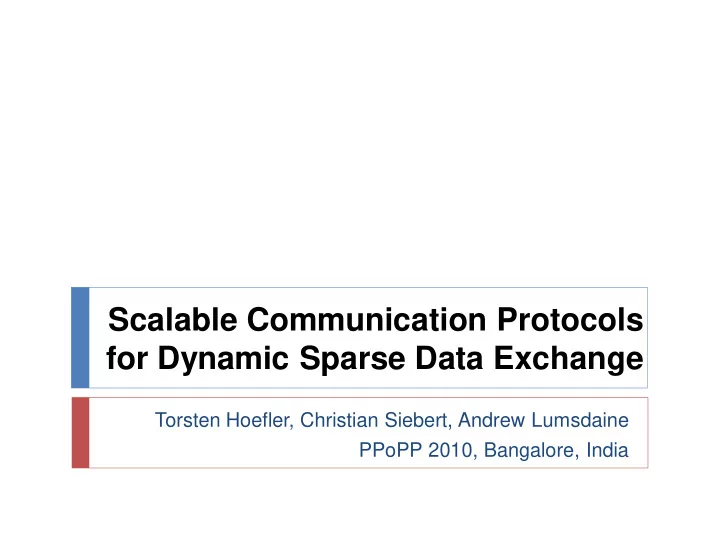

Scalable Communication Protocols for Dynamic Sparse Data Exchange Torsten Hoefler, Christian Siebert, Andrew Lumsdaine PPoPP 2010, Bangalore, India
The Sparse Data Exchange Problem Defines a generic communication problem Assume a set of P processes Each process communicates with a small set of other processes (called neighbors) How do we define “sparse”? The maximum number of neighbors (k) is Dynamic vs. Static SDE Static: neighbors can be determined off-line e.g., sparse matrix vector product Dynamic: neighbors change during computation e.g., parallel BFS 2 Torsten Hoefler, PPoPP 2010, Bangalore, India
Dynamic Sparse Data Exchange (DSDE) 3 Torsten Hoefler, PPoPP 2010, Bangalore, India
Our Contribution Analyze well-known algorithms for DSDE: Personalized Exchange (MPI_Alltoall) Personalized Census (MPI_Reduce_scatter) Remote Summation (MPI_Accumulate) Focus on large-scale systems (large P) Metadata exchange easily dominates runtime! Propose a new, asymptotically optimal algorithm Uses nonblocking collective semantics (MPI_Ibarrier) Can take advantage of hardware support Introduces a new way of thinking about synchronization 4 Torsten Hoefler, PPoPP 2010, Bangalore, India
Preliminaries Distributed Consensus All processes agree on a single value Lower bound: broadcast Personalized Census All processes agree on a different value for each process Each process sends a contribution for each other proc. Personalized Exchange All processes send different values to all other processes 5 Torsten Hoefler, PPoPP 2010, Bangalore, India
Dynamic Sparse Data Exchange (DSDE) Main Problem: metadata Determine who wants to send how much data to me (I must post receive and reserve memory) OR: Use MPI semantics: Unknown sender MPI_ANY_SOURCE Unknown message size MPI_PROBE Reduces problem to counting the number of neighbors Allow faster implementation! 6 Torsten Hoefler, PPoPP 2010, Bangalore, India
Protocol PEX (Personalized Exchange) 7 Torsten Hoefler, PPoPP 2010, Bangalore, India
Protocol PEX (Personalized Exchange) Bases on Personalized Exchange ( ) Processes exchange metadata (sizes) about neighborhoods with all-to-all Processes post receives afterwards Most intuitive but least performance and scalability! 8 Torsten Hoefler, PPoPP 2010, Bangalore, India
Protocol PCX (Personalized Census) 9 Torsten Hoefler, PPoPP 2010, Bangalore, India
Protocol PCX (Personalized Census) Bases on Personalized Census ( ) Processes exchange metadata (counts) about neighborhoods with reduce_scatter Receivers checks with wildcard MPI_IPROBE and receives messages Better than PEX but non-deterministic! 10 Torsten Hoefler, PPoPP 2010, Bangalore, India
Protocol RSX (Remote Summation) 11 Torsten Hoefler, PPoPP 2010, Bangalore, India
Protocol RSX (Remote Summation) Bases on Personalized Census (MPI_Win_fence): Processes accumulate number of neighbors in receiver’s memory Receivers check with wildcard MPI_IPROBE and receives messages Faster than PEX/PCX, non-deterministic and requires (good) RMA! 12 Torsten Hoefler, PPoPP 2010, Bangalore, India
Nonblocking Collective Operations (NBC) It is as easy as it sounds: MPI_Ibarrier() Decouple initiation and synchronization Initiation does not synchronize Completion must synchronize (in case of barrier) Interesting semantic opportunities Start synchronization epoch and continue Possible to combine with other synchronization methods (p2p) NBC accepted for MPI-3 Available as reference implementation (LibNBC) LibNBC optimized for InfiniBand Optimized on some architectures (BG/P, IB) 13 Torsten Hoefler, PPoPP 2010, Bangalore, India
Protocol NBX (Nonblocking Consensus) 14 Torsten Hoefler, PPoPP 2010, Bangalore, India
Protocol NBX (Nonblocking Consensus) Complexity - census (barrier): Combines metadata with actual transmission Point-to-point synchronization Continue receiving until barrier completes Processes start coll. synch. (barrier) when p2p phase ended barrier = distributed marker! Better than PEX, PCX, RSX! 15 Torsten Hoefler, PPoPP 2010, Bangalore, India
Performance of Synchronous Send Worst-case: 2*L Bad for small messages Myrinet 2000/MX Vanishes for large messages Benchmark Slowdown for 1-byte messages Threshold = size when overhead is <1% System L (synch) Slowdown Threshold Intrepid (BG/P) 5.04 us 1.17 12 kiB Jaguar (XT-4) 25.40 us 2.57 132 kiB Big Red (Myrinet) 8.02 us 1.13 1.5 kiB Very good results for BG/P and Myrinet! 16 Torsten Hoefler, PPoPP 2010, Bangalore, India
LogP Comparison – PCX vs. NBX k=number of neighbors, assuming L(synch) = 2*L BlueGene/P Cray XT-4 NBX faster for few neighbors and large scale! 17 Torsten Hoefler, PPoPP 2010, Bangalore, India
Microbenchmark Each process sends to 6 random neighbors BlueGene/P Cray XT-4 Significant improvements at large scale! 18 Torsten Hoefler, PPoPP 2010, Bangalore, India
Parallel Breadth First Search On a clustered Erd ő s-Rényi graph, weak scaling 6.75 million edges per node (filled 1 GiB) BlueGene/P – with HW barrier! Myrinet 2000 with LibNBC HW barrier support is significant at large scale! 19 Torsten Hoefler, PPoPP 2010, Bangalore, India
Are our assumptions for k realistic? Check with two applications: Parallel N-body (Barnes&Hut) (512 processes) Number of neighbors in rebalancing ORB step: 20 Torsten Hoefler, PPoPP 2010, Bangalore, India
Are our assumptions for k realistic? Sparse linear algebra (CFD, FEM, …) Used simple block-distribution of UFL matrices Graph partitioning techniques would reduce k further! 21 Torsten Hoefler, PPoPP 2010, Bangalore, India
Conclusions and Future Work SDSE problem is important Metadata exchange dominates at large scale! We discussed four algorithms and their complexity NBX is fastest for large machines and small k RCX is probably most “convenient” Hardware support for NBC crucial at large scale! Synchronous sends can be performance critical! We plan to work on an self-tuning adaptive library Automatic algorithm selection Look into large-scale applications 22 Torsten Hoefler, PPoPP 2010, Bangalore, India
Thank you for your attention! Questions? 23 Torsten Hoefler, PPoPP 2010, Bangalore, India
Orthogonal Recursive Bisection 24 Torsten Hoefler, PPoPP 2010, Bangalore, India
Influence of the Number of Neighbors “ sparsity ” -factor is important for algorithm choice! 25 Torsten Hoefler, PPoPP 2010, Bangalore, India
Quick Terms and Conventions We use standard LogGP terms L – maximum latency between any two processes o – CPU send/recv overhead g – time to wait between network injections G – time to transmit a single byte P – number of processes in the parallel job One single byte messages from A to B: costs o on A and arrives after 2o+L on B We assume that o>g for simplicity All parallel processes start at t=0 26 Torsten Hoefler, PPoPP 2010, Bangalore, India
Recommend
More recommend